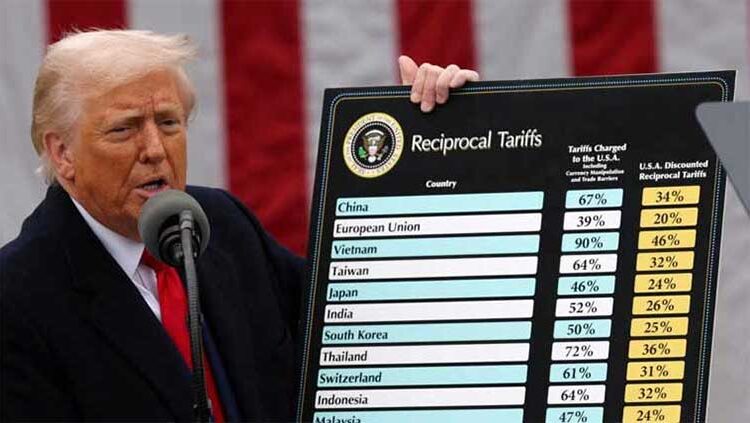Trump Tariffs: Impact and Path Forward for Pakistan
By: Khurram Pervaiz (Development Economist)
US President Donald Trump’s across the board tariff hikes up to 46 per cent on some partners and a flat 29 % on Pakistan continue to polarise economists, yet the raw numbers suggest a policy that has already re-routed capital on a grand scale. Since the first wave of duties was unveiled, corporates and sovereign funds have pledged more than US $3 trillion for new plants, supply chains and jobs in the United States, led by US $1.4 trillion from the UAE, US $600 billion from Saudi Arabia and US $500 billion from Apple, with hefty promises from Oracle, SoftBank, Siemens, TSMC, Johnson & Johnson, Eli Lilly, Honda and Hyundai. Supporters argue the surge vindicates Mr Trump’s conviction that access to the world’s richest consumer market is a privilege, not a right.
Tariffs themselves are hardly new in American economic life. Until the federal income tax appeared in 1913 they financed government and fuelled industrialisation. By the early 2000s, however, the average US duty had slipped to barely three to four percent, far below the tariff walls maintained by partners such as India or the EU. Mr Trump’s “reset” now leaves China facing 34 %, Vietnam 46 %, the EU 20 % and Pakistan 29 %. Treasury projections suggest the measures could yield US $300 billion a year by 2025 and US $3.2 trillion over a decade, functioning more as a consumption tax that nudges buyers toward US-made goods than as a blanket price shock.
For Pakistan the figures are sobering. The United States absorbs roughly US $6 billion of Pakistani exports or about 18 % of the total and good for a US $3 billion surplus. Yet those consignments account for just 0.16 pc of America’s US $3.36 trillion import bill. Textiles supply three-quarters of the flow, followed by leather, surgical instruments, rice and cement. Rival suppliers Bangladesh and Vietnam now face duties up to 46 %, but India enjoys a slight edge at 26 %, leaving Pakistan’s mills scrambling to hold market share.
Analysts urge calm even as they concede the severity of the blow. They point out that exports to the United States make up under 1.5 per cent of Pakistan’s GDP, a vulnerability rooted as much in earlier policy missteps as in external shocks, yet apparel that once entered the US at 22 % duties now faces rates close to 49 pc, a jump too steep for many low-margin producers to bear.
The squeeze comes just as large Pakistani mills were banking on orders diverted from China and Vietnam, both hit harder by the new regime. Brokerage research warns that listed firms such as Interloop, Gul Ahmed, Nishat Mills and Kohinoor Textile could see margins erode unless they climb the value chain or pass costs to buyers. India’s three-point tariff advantage in key apparel codes 61, 62, 63 and 52 only sharpens the competitive edge.
A near-term drop in orders and mounting cash-flow pressure is expected, with some observers arguing that only subsidised credit or cheaper energy could keep exporters competitive, precisely the sort of relief the IMF, now poring over Islamabad’s next programme, is unlikely to endorse.
Diplomacy, not retaliation, is Islamabad’s chosen path. While Pakistan’s average duty on US goods already stands at 58 % well above the 7.3 pc trade-weighted average for other partners, officials hope product-specific relief can be won by highlighting that American cotton enters duty-free, soyabean at 3.25 % and meat at 5 to 10 %, even as finished garments face tariffs near 50 %. A team led by Finance Minister Muhammad Aurangzeb has instructed the embassy in Washington to press the US Trade Representative for talks.
The macro picture remains manageable. Bilateral trade totalled US $7.3 billion in 2024, leaving Pakistan with a US $3 billion surplus, but the concentration risk is stark: one buyer dictates terms for nearly a fifth of national exports, and every lost percentage point threatens jobs in districts already grappling with power outages and ageing machinery.
Officials therefore talk of a two-pronged response. First, preserve the US foothold perhaps by sourcing more upstream inputs from America to qualify for concessions. Second, accelerate diversification: exploit the EU’s GSP-Plus window, court niche demand in Africa and Latin America, and use the China–Pakistan Economic Corridor to knit local producers into regional supply chains. All of this will demand an industrial package at home simpler tariffs, removal of anomalies, concessional finance for technology upgrades and aggressive promotion of non-cotton sectors such as copper, furniture and processed foods.
Global markets are still parsing the fallout. Oil slid seven per cent on the announcement, bond yields softened and equities wobbled amid speculation that steeper trade barriers could cool demand enough to force the US Federal Reserve into rate cuts, an outcome that would let Washington refinance its ballooning debt on cheaper terms. Whatever the motive, a world accustomed to ever-freer commerce must now reckon with a super-power willing to weaponise its consumer market.
For Pakistan the lesson is clear. We can not blame Trump as having being popularly elected as the President of USA, he has the mandate to decide what he feels is the best for his people. For us this 29 % levy lands as a body-blow rather than a knockout, but it exposes the cost of complacency: a narrow export basket, heavy dependence on a single customer and limited fiscal space to cushion shocks. Used wisely, the crisis could catalyse overdue reform of modernising factories, broadening the product mix and striking smarter trade deals. Ignored, it risks ceding hard-won market share not just to India’s mills but to any producer nimble enough to fill America’s order books.


Comments are closed, but trackbacks and pingbacks are open.